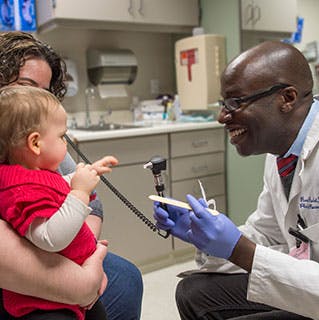Head Shape in Infants: Synostosis & Plagiocephaly
To prevent sudden infant death syndrome (SIDS), the American Academy of Pediatrics recommends that babies sleep on their backs. Although our pediatric experts agree, it has given rise to a problem: When a baby sleeps only on his or her back, skull growth and development can be unfavorably affected.
How a Baby's Skull Forms
The skull consists of a number of bone plates that are naturally knitted together at sutures, or seams, where the bone plates overlap. One long suture goes from back to front in the middle of the skull. Other sutures extend to the forehead, sides and back of the skull. The body produces new bone at the suture lines. This allows the bones to grow evenly, resulting in an evenly shaped head.
The top and back of a newborn’s skull are very flexible. Many cultures, including ancient Egyptians and some Native American tribes, took advantage of this flexibility to mold babies’ heads into different shapes. They did this by wrapping bands around babies’ heads or placing babies on flat headboards.
Now, some modern parents are inadvertently doing the same thing. When a baby sleeps only on their back with the soft, thin bones at the back of the head supporting the weight of the skull and brain, a similar molding of the skull can occur. This condition is known as positional molding.
Because the baby’s head is very soft in both the bone and brain layers, it tends to deform like a beanbag — flattening in the back and front and widening on the sides. If your baby prefers one side of the back of his or her head to the other, the skull can take on an asymmetrical, lopsided shape. If most of the flattening is in the back of his head, it may be covered by hair and barely noticeable. But if the shape of the front and sides of his or her head also are affected, parents are likely to notice and to worry.
As with so many childhood conditions, prevention is preferable to treatment. Parents can minimize positional molding by rotating their baby’s sleeping position from side to side to back, making sure the baby doesn’t sleep in the same position all night, every night. And remember, "normal" heads come in many shapes and sizes. As long as an unusual head shape doesn’t cause developmental or social problems, there is no need to worry.
Most skull malformations do not pose a risk to a child’s developing brain. Still, if a child’s head appears different, he or she may be ridiculed by others and a child's social development can suffer. For this reason, some parents seek treatment even when the condition is not medically dangerous.
In rare cases, a malformed, asymmetrical skull might be a danger to a child’s developing brain. Occasionally, the sutures of a child’s skull close prematurely or fail to develop properly. This is known as craniosynostosis or synostosis. If only one suture is affected, a child’s skull may appear misshapen. It is unlikely that early damage will be caused to the brain, though problems can arise in the long term. But if synostosis occurs at more than one suture, the skull may begin to press on the brain and can interfere with a child’s cognitive development.
If you are concerned about the shape of your child’s head, visit your pediatrician or consult a neurosurgeon to relieve your fears. A doctor usually can rule out synostosis simply by looking at your child’s head from above. If the ear on the flattened side of the head is pushed forward, positional molding probably is the culprit. If the ear is gathered back toward the flattened area, this may be a sign of synostosis. Treatment will depend on the age of your child and the state of the molding.
Although true synostosis can be corrected only by surgery, there are several less invasive options for babies with positional molding. If a baby’s head and face look symmetrical from the front and their head is flattened only in back, the head’s rounded shape may be restored by positioning the infant away from the flat side at night and keeping them as erect as possible when awake.
If the asymmetry affects the front of a baby’s face, just positioning him or her differently may not be enough to correct the problem. Sometimes babies younger than age one can successfully be treated with a molding helmet. The helmet is custom fitted to the child’s head and worn up to 23 hours a day. Many children quickly adjust to wearing the helmet. By the time a child is about 18 months old, his or her head shape may have "rounded out."
In severe cases of asymmetry, especially in older children whose bone growth has slowed, the only way to undo head molding may be surgical reconstruction of the skull bones.
Please feel free to contact us with questions.
Telephone: 773-702-6302
Fax: 773-702-1634
Mailing Address:
The University of Chicago Medicine
Craniofacial Anomalies Multidisciplinary Program (CAMP)
5841 S. Maryland Ave., MC 3027
Chicago, IL 60637
Clinical Coordinators
Kelly Postma, RN, BSN
773-702-1513
Heather Bailin, RN, BSN
773-702-6302
Administrative Coordinator
Valerie Schlegel
773-795-4525

Craniofacial Anomalies Multidisciplinary Program (CAMP)
Our Craniofacial Anomalies Multidisciplinary Program (CAMP), one of the largest in the region, provides a thorough, team-based approach for the evaluation, diagnosis and treatment of children with craniosynostosis.
Learn more about our CAMP program